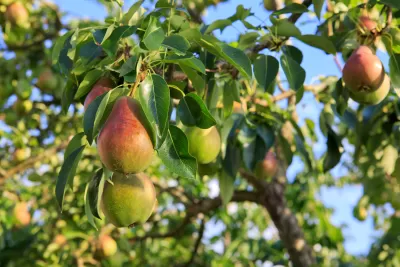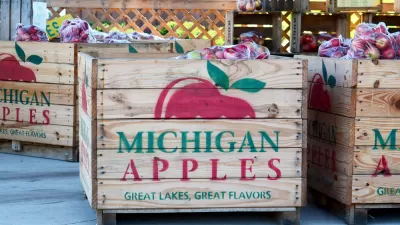The Common Orchard Project has planted ten orchards in vacant lots in Cincinnati. The organization hopes to plant 100 urban orchards by the end of the decade.

"Vacant lots are a blight to communities across the country, and Cincinnati is no different. According to an inter-departmental study on vacant land and health in Philadelphia, blighted plots affect residents’ well-being, physical health, and mental health," warns The Common Orchard Project, an organization replacing vacant lots with fruit-bearing trees.
WVXU reporter Ann Thompson caught up with the project's founder and permaculturist, Chris Smyth, at the first orchard at Schiff Ave and Glenway Ave in West Price Hill. Smyth says the organization plans to plant 100 orchards in the next decade.
"It's easy to drive by the intersection of Glenway and Schiff avenues and not realize this green space is actually a 'food forest' that is helping feed people who live in the neighborhood," Thompson writes.
Once home to two unused, crumbling buildings, the lot now supports "apple, cherry, pear, pecan and plum trees" as well as medicinal plants and other vegetation that promote healthy trees by fending off pests and providing nutrient-rich soil.
So far, Smyth's team has planted 10 orchards in Cincinnati. "Smyth sees Common Orchards as a way to bridge the gap between vacant property and eventual development," says Thompson. The Common Orchard Project team hopes to promote the project and see orchards across Ohio.
FULL STORY: A Fruitful Effort Is Happening Near Cincinnati's Food Deserts

Alabama: Trump Terminates Settlements for Black Communities Harmed By Raw Sewage
Trump deemed the landmark civil rights agreement “illegal DEI and environmental justice policy.”

Planetizen Federal Action Tracker
A weekly monitor of how Trump’s orders and actions are impacting planners and planning in America.

The 120 Year Old Tiny Home Villages That Sheltered San Francisco’s Earthquake Refugees
More than a century ago, San Francisco mobilized to house thousands of residents displaced by the 1906 earthquake. Could their strategy offer a model for the present?

In Both Crashes and Crime, Public Transportation is Far Safer than Driving
Contrary to popular assumptions, public transportation has far lower crash and crime rates than automobile travel. For safer communities, improve and encourage transit travel.

Report: Zoning Reforms Should Complement Nashville’s Ambitious Transit Plan
Without reform, restrictive zoning codes will limit the impact of the city’s planned transit expansion and could exclude some of the residents who depend on transit the most.

Judge Orders Release of Frozen IRA, IIJA Funding
The decision is a victory for environmental groups who charged that freezing funds for critical infrastructure and disaster response programs caused “real and irreparable harm” to communities.
Urban Design for Planners 1: Software Tools
This six-course series explores essential urban design concepts using open source software and equips planners with the tools they need to participate fully in the urban design process.
Planning for Universal Design
Learn the tools for implementing Universal Design in planning regulations.
Clanton & Associates, Inc.
Jessamine County Fiscal Court
Institute for Housing and Urban Development Studies (IHS)
City of Grandview
Harvard GSD Executive Education
Toledo-Lucas County Plan Commissions
Salt Lake City
NYU Wagner Graduate School of Public Service




























